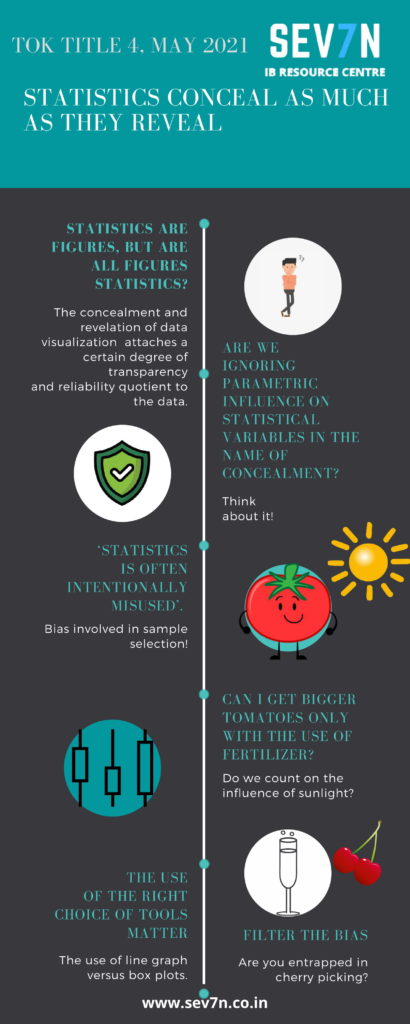TOK Title 4
Get In Touch
TOK TITLE 4 – “Statistics conceal as much as they reveal.” Discuss this claim with reference to two areas of knowledge.
WHAT DOES STATISTICS AIM TO DO?
The very common questions which trigger our thought process are– ‘Statistics are figures, but are all figures statistics?’ When we statistically analyze the recovery rate of the COVID patients, do we use percentage or percentile? Are we trying to conduct an atypical variable value analysis of an individual or a comparative one?
Can we afford to be complacent with the reasonable standard of accuracy which the results depict? How do we get to see a vivid picture of the degree of transparency of the data visualization and interpretation
PARAMETERS AS INFLUENCERS OF SUBJECTIVITY
Do we get to see an expected transparent revelation of growth of organic vegetation due the use of home-made fertilizers? What about the impact of sunlight or rainfall on the response variable?
FALLING INTO THE PITFALL-THE BIAS TRAP
‘There are three kinds of lies: lies, damned lies, and statistics’- have you heard of this claim?
When can statistics be claimed to come up with false statements and results? Well, we just can’t afford to ignore the fallacies which are created due to selection bias.
THE CHOICE OF TOOLS
The natural tendency of scientists in research is to use line and bar graphs. The cons are lack of transparency in data visualization, focus on the standard error, or the accuracy of mean instead of the variation.
Let’s analyze the claim looking at it from the perspectives of different AOKs.
STATISTICAL DATA IN HISTORY
Sebayt, the ancient Egyptian term for a genre of pharaonic literature and its uses as a popular manuscript has been statistically testified. Don’t you think this is a pretty comprehensive revelation of the data?
STATISTICAL REASONING IN HUMAN SCIENCE
Well, have you heard of the placebo magic? It’s surprising to believe that sham treatment in the form of sterile water can statistically represent a positive impact on a certain number of people in one group, whereas no impact on the same number of people in another group. What I mean here is, the sample size remains the same. Both groups are unaware of the placebo administration.
So, how come the data visualization results are different for the same sample sizes?
THE RATIONALE
Many such mind-boggling questions will make you think and rethink, construct and reconstruct your arguments. However, the only path which would help you analyze the contestability of the claim and counterclaim with objectivity is the adoption of advanced tools, simulation models, and interactive techniques.

Related: TOK TITLE 5, TOK TITLE 6, TOK TITLE 3, TOK TITLE 2, TOK TITLE 1

We guarantee quality process
Let’s join our community today
Join SEV7N's vibrant community of elite educators—a collaborative space where innovation meets expertise. Share resources, discuss teaching strategies, and stay ahead of educational trends. Benefit from a support network that enhances your professional growth, enriches your teaching practices, and elevates your impact on students. It's not just a community; it's your gateway to educational excellence.